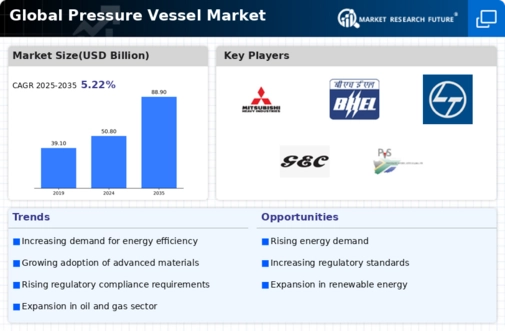Top Industry Leaders in the Pressure Vessel Market

*Disclaimer: List of key companies in no particular order
The pressure vessel market, which includes containers designed for holding gases or liquids at specific pressures, is characterized by a multifaceted and competitive landscape. Driven by applications in crucial industries such as oil & gas, chemicals, and power generation, this market is in a constant state of change influenced by evolving industry trends, technological advancements, and strategic moves by key players. Let's explore the complexities of this sector, examining the strategies employed by industry leaders, the pivotal factors affecting market share, and the emerging trends shaping its future.
Strategies of Key Players: Major players in this market, including Babcock and Wilcox Enterprises, Inc. (U.S.A), Doosan Heavy Industries & Construction Co., Ltd. (South Korea), Mitsubishi Heavy Industries Ltd. (Japan), Bharat Heavy Electricals Limited. (India), Larsen & Toubro Limited. (India), Dongfang Electric Machinery Co., Ltd. (China), General Electric Co (U.S.A), Halvorsen (Norway), IHI Corporation (Japan), Pressure Vessels (India), Samuel Pressure Vessel Group. (U.S.A), Westinghouse Electric Company LLC. (U.S.A), and others, employ various strategies to navigate this dynamic market.
- Market Leaders: Established giants like Mitsubishi Hitachi Power Systems, IHI Corporation, and Babcock & Wilcox maintain significant market share through their extensive experience, robust manufacturing capabilities, global reach, and strong brand recognition. Investments in research & development (R&D) for advanced materials and innovative designs enable them to cater to diverse application needs and stay ahead.
- Challengers: Rising regional players such as Bharat Heavy Electricals Limited (BHEL), Larsen & Toubro, and China's Shandong Weifang Hengyuan Pressure Vessel Manufacturing Co. Ltd. challenge established players by leveraging cost-competitiveness, proximity to high-growth markets, and strategic acquisitions or collaborations with technology providers.
- Niche Players: Smaller, specialized companies focus on specific applications or materials, offering customized solutions that cater to unique industry needs. Their agility and use of emerging technologies like composite materials and additive manufacturing give them a competitive edge.
Factors Influencing Market Share Analysis: Several factors influence market share in the pressure vessel market:
- Geography: Regional demand patterns, with the Asia Pacific region leading in rapid industrialization, significantly impact market share. North America and Europe remain significant players, while Latin America and Africa offer potential for future growth.
- Application: The type of pressure vessel is crucial, with processing vessels for chemical and petrochemical applications holding the largest share. Emerging opportunities are seen in segments like nuclear power and renewable energy.
- Material: Advancements in material science, such as the use of composite materials or nickel alloys, offer competitive advantages depending on factors like pressure, temperature, and corrosion resistance.
- Regulations: Stringent safety regulations governing pressure vessel design, manufacturing, and operation require players to invest in compliance measures.
Emerging Trends and Innovations: Several trends and innovations are shaping the pressure vessel market:
- Digitalization: The integration of digital technologies like AI, data analytics, and IoT is transforming the industry, optimizing production and enhancing safety.
- Lightweight Materials: The demand for lighter, more energy-efficient vessels is driving the adoption of composite materials like carbon fiber.
- Sustainability: Environmental concerns are pushing manufacturers towards sustainable practices, making energy-efficient designs and recycling initiatives key differentiators.
Overall Competitive Scenario: The pressure vessel market is witnessing dynamic competition between established players, regional growth, emerging trends, and technological advancements. While cost-competitiveness remains crucial, factors like material expertise, digitalization, and sustainability are gaining importance. Adapting to evolving industry demands and embracing disruptive technologies are key to success in this dynamic market.
Moving Forward: Understanding the competitive landscape is crucial for both established players and new entrants. By analyzing key player strategies, market share influencing factors, and emerging trends, companies can formulate winning strategies and capitalize on growth opportunities. Embracing innovation, fostering sustainability, and building agility will be crucial for navigating the ever-evolving pressure vessel market.
Industry Developments and Latest Updates: Recent updates from key players include:

